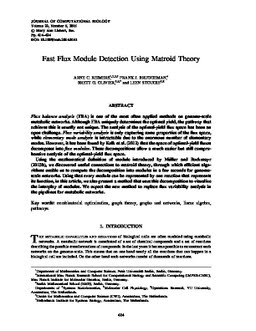2015
Fast flux module detection using matroid theory
Publication
Publication
Journal of Computational Biology , Volume 22 - Issue 6 p. 414- 424
Flux balance analysis (FBA) is one of the most often applied methods on genome-scale metabolic networks. Although FBA uniquely determines the optimal yield, the pathway that achieves this is usually not unique. The analysis of the optimal-yield flux space has been an open challenge. Flux variability analysis is only capturing some properties of the flux space, while elementary mode analysis is intractable due to the enormous number of elementary modes. However, it has been found by Kelk et al. (2012) that the space of optimal-yield fluxes decomposes into flux modules. These decompositions allow a much easier but still comprehensive analysis of the optimal-yield flux space.
Using the mathematical definition of module introduced by Mu ̈ller and Bockmayr (2013b), we discovered useful connections to matroid theory, through which efficient algorithms enable us to compute the decomposition into modules in a few seconds for genome- scale networks. Using that every module can be represented by one reaction that represents its function, in this article, we also present a method that uses this decomposition to visualize the interplay of modules. We expect the new method to replace flux variability analysis in the pipelines for metabolic networks
| Additional Metadata | |
|---|---|
| doi.org/10.1089/cmb.2014.0141 | |
| Journal of Computational Biology | |
| Organisation | Evolutionary Intelligence |
|
Reimers, A., Bruggeman, F., Olivier, B., & Stougie, L. (2015). Fast flux module detection using matroid theory. Journal of Computational Biology, 22(6), 414–424. doi:10.1089/cmb.2014.0141 |
|

